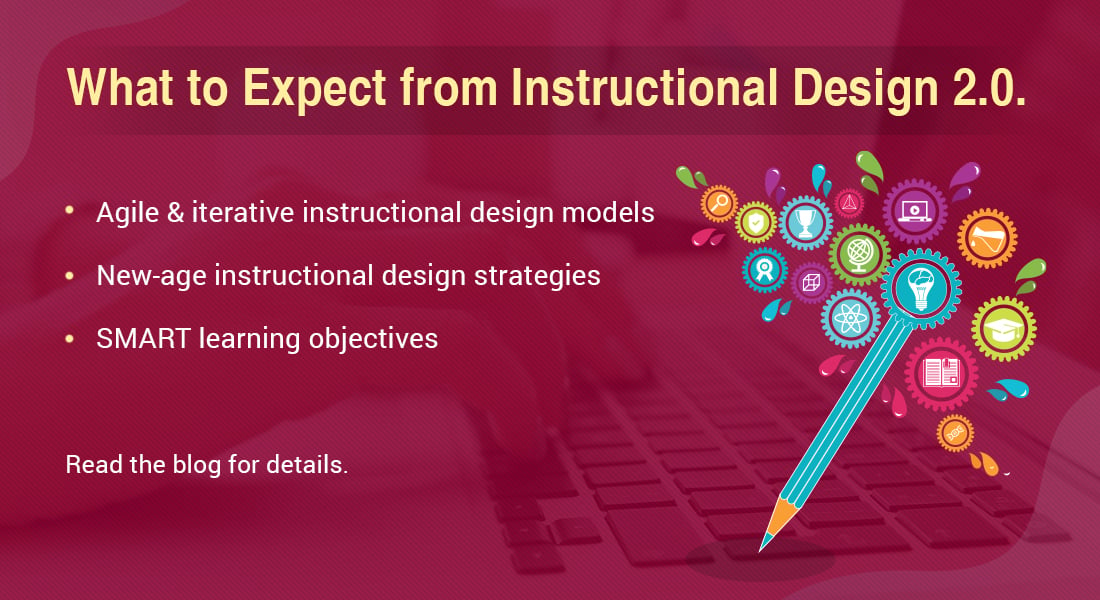Top 3 Instructional Design Models for Effective and Engaging Training Materials

Instructional design is like planting a garden. Just as a gardener must carefully plan and cultivate the soil, select the right seeds, provide the right amount of water and sunlight, and continuously tend to their garden to ensure healthy growth, instructional designers must carefully plan, develop, and refine the training content to help learners grow their knowledge and skills. By using a systematic approach, instructional designers can cultivate a rich and fruitful learning experience where learners can flourish and reach their full potential. Just as a beautiful garden requires a skilled gardener, designing effective learning requires a well-designed instructional plan.
Instructional Design Models for a Powerful eLearning Impact!
Here are the top 3 that steal the show:
- The ADDIE Model
- The SAM Model
- Gagne’s Nine Events of Instruction
And just like there are different methods and approaches to gardening, there are also various instructional design models to choose from. These models provide a framework for organizing and structuring the instructional design process. Some popular models are the ADDIE model, the SAM model, and Gagne’s Nine Events Instructional Design. Each model offers a unique set of steps and techniques for designing the instructional material. With that said, you can choose the instructional design model that best suits your needs based on the specific learning objectives and audience.
To help make it easy for you to make the right choice, I’ve discussed the top 3 instructional design models in detail. So why wait? Let’s start!
Top 3 Instructional Design Models to Develop Effective and Engaging Training Material
By using these models as a guide, you can facilitate learning experiences that are both effective and engaging. Just as a skilled gardener knows which plants will thrive in different climates and soils, instructional designers know how to adapt their methods to suit different learning environments and learners.
#1. The ADDIE Model
The ADDIE model is an instructional design model that stands for Analysis, Design, Development, Implementation, and Evaluation. The model provides a five-phase framework for designing and developing effective training courses. It is a popular choice and is widely used in the field of instructional design as it provides a structured and comprehensive approach to creating effective learning experiences. Let’s explore each phase of the ADDIE model in detail:
Analysis
In this first phase, you need to assess the learning needs of your target audience, identify the goals and objectives of the instructional program, and gather information about the existing knowledge and skills of the learners. Moreover, you also need to check the content and resources required to meet the training objectives. With that said, it is equally important to consider and be cautious about the constraints and limitations of the instructional environment. Basically, the goal of the analysis phase is to gather sufficient information to help you make informed decisions about the instructional design and ensure that the instructional program fulfills the desired expectations of both the learners and the organization.
Design
The second phase in the ADDIE model is design. Here you translate the instructional goals and objectives into specific learning outcomes and select the instructional design strategy and methods that best serve the learning needs. You also need to create a detailed plan for the eLearning course, including a blueprint of the content, assessment methods, and tools and technology. The design phase helps you create a detailed and comprehensive plan for the eLearning design and development process that ensures the needs and expectations of the learners are met successfully.
Check out these amazing instructional design strategies and develop effective eLearning courses now!
Development
During this phase, you create and develop the eLearning courses, including the content, assessments, and even interactivities. After all this, you need to analyze and be sure of the effectiveness and quality of the training material, so you perform a quality check. The development phase enables you to create high-quality eLearning courses that are engaging, effective, and accessible.
Implementation
In this fourth phase, the eLearning courses take center stage as they are rolled out to the intended learners. The implementation phase helps you ensure that the program is delivered with precision and meets all learning objectives. Furthermore, it also enables you to make the training material more accessible and impactful for the learners.
Evaluation
During the evaluation phase, you assess the training program’s effectiveness, gather feedback from the learners as well as the stakeholders, and evaluate the training ROI against learning objectives. The major purpose of this phase is to verify that the training materials meet the client’s needs and expectations and to pinpoint areas for improvement for continuous quality improvement.
#2. The SAM Model
In eLearning design and development, the Successive Approximation Model (SAM) is a useful approach for designing and building effective and engaging online courses. It involves breaking down the whole course development process into smaller, more manageable steps and iteratively refining each step until the desired result is achieved. It basically consists of three main phases— the preparation phase, the iterative design phase, and the iterative development phase. So, let’s learn more about each phase below:
Preparation Phase
The first phase of SAM is preparation. It is essential for the success of this model as it lays the foundation for the subsequent phases, allowing eLearning designers and developers to refine and optimize the training material in an incremental manner. During this phase, learning objectives and goals are identified as well as analyzed.
The design team determines the target audience, their needs and preferences, and the content and instructional strategies that will be used to meet those needs. They also break down the project into its constituent components, creating an outline or roadmap for the project. Furthermore, eLearning designers also identify the resources needed for the project, such as software or content. They might also create a timeline and budget for the project, as well as a list of stakeholders.
Iterative Design Phase
The second phase, i.e., the iterative design, is where the design team creates a rough draft or a prototype of the eLearning course. This prototype can include the course structure, text, images, videos, interactive elements, and other instructional materials. The goal of this phase is to create a basic representation of the course and to test its feasibility and effectiveness.
The iterative design phase in Successive Approximation Model (SAM) is a key component of the model that involves creating, testing, and refining the eLearning course in a repetitive cycle until it meets the desired standards of quality and engagement.
With that said, SAM also enables the design team to work on the eLearning course incrementally, making small but continuous improvements along the way. This approach helps to minimize risks and to ensure that the final product meets the needs of the target audience and achieves the desired learning outcomes.
Iterative Development Phase
The third and final phase is iterative development. It refers to the process of developing and implementing the feedback received in the previous phase. This helps in continuously refining and improving the eLearning course development process through repeated cycles. It includes multiple stages like creating the storyboard, chunking the content, visualization, designing interactivities, framing assessments, creating an audio script, maintaining technical standards, and finally running a quality check.
This phase in SAM enables the eLearning developers to make continuous improvements to the eLearning course as they work on it to ensure the final outcome is as per the client’s expectation and is aligned with the learning objectives, thereby boosting learner engagement and efficiency.
#3. Gagne’s Nine Events of Instruction
In terms of effectiveness, impact, and engagement, design your eLearning courses to the nines with Gagne’s Nine Events of Instruction. It is an instructional design model developed by Robert Gagne in the 1970s that enables well-planned and structured design and development of the training material. It is based on the idea that learning is a process that occurs in stages. Now let’s take a quick look at the nine events of instruction:
- Gain Attention: It emphasizes that you should attract the learners’ attention and make them interested in the learning material. You can do so by incorporating various interactivities and activities.
- Inform Learners of Objectives: Providing an outline of the course is important. So, clearly state the learning objectives and what the learners are expected to achieve. It helps learners connect the dots and prepare themselves for learning.
- Stimulate Recall of Prior Learning: Build on the foundation of what your learners already know. Connect the new information to the prior knowledge related to the learning material.
- Present the Content: Deliver the training content in an organized and clear manner. Avoid using extra fluff and segregate the need-to-know content from nice-to-know content. Focus on the essential content that helps learners augment their skills and knowledge.
- Provide Learning Guidance: From infographics to videos to audio, use various assets and techniques to guide learners through the learning process.
- Elicit Performance: Encourage learners to practice and apply what they have learned. You can leverage the teach-back method, assign projects, etc. This helps the learners gain clarity and boosts their confidence.
- Provide Feedback: Without feedback, all that you do is always right. Sadly, that’s not always the reality. So it is crucial to offer your learners immediate feedback on their performance and progress. You can suggest and guide them on how they can improve and appreciate their good work.
- Assess Performance: Evaluate the learners’ understanding of the material and their ability to apply what they have learned. You can include formative and summative assessments to ensure your learners are understanding all that is being conveyed to them.
- Enhance Retention and Transfer: Encourage learners to retain the information by providing them with multiple opportunities to repeat and reinforce the acquired knowledge and then transfer the information to real-world scenarios and situations by implementing it.
Wrapping It Up!
Adorn your garden of corporate training with plants and flowers of immersive, engaging, and highly-effective eLearning courses. For this, you need to sow the seeds of the right instructional design model and nurture it with regular evaluation and feedback. From the options mentioned above, select the model that aligns well with your training needs and overall business goals. Also, check out these incredible instructional design strategies to elevate the quality and impact of your eLearning courses.





